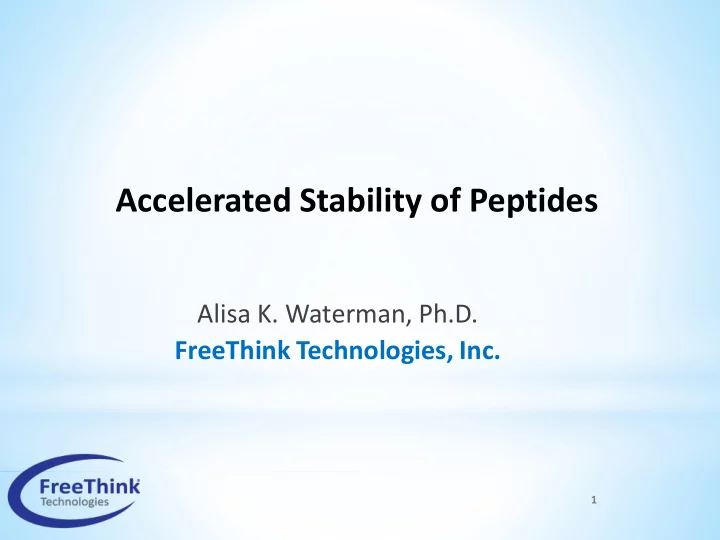

Accelerated Stability of Peptides Alisa K. Waterman, Ph.D. FreeThink Technologies, Inc. 1
Considerations for Stability of Small Molecule vs. Proteins Small Molecules Proteins • Subject to chemical modifications • Subject to chemical modifications such as oxidation, deamination, such as oxidation, deamination, hydrolysis hydrolysis • Chemical modifications may or may • Chemical modifications generally not impact activity lead to loss of potency • Impact on 1 , 2 , 3 and 4 • Only concerned with primary structure must be considered structure • Small changes in structure can have • Often shelf-life limited by formation a large impact on activity and of low levels of degradants aggregation state • Stability indicating analytical • Requirement for a panel of assays method feasible for determination of a stability indicating profile 2
Considerations for Stability of Small Molecule vs. Proteins Small Molecules Proteins • Follow Arrhenius behavior in • Undergo multiple reversible and solution and modified Arrhenius irreversible steps making behavior in solid state Arrhenius behavior more difficult to detect even in solution Can the humidity modified Arrhenius equation be utilized to effectively model protein stability? • Initial approach - evaluate peptides o Chemical changes more likely to impact stability o Less likely to have complex higher order structure o Can track using a single analytical method (HPLC) 3
Can ASAP be Used to Model Shelf-life of Biologics? Goal: Determine the applicability of the A ccelerated S tability A ssessment P rogram ( ASAP ) to rapidly model the shelf-life of a peptide • Samples are incubated at elevated temperatures and RHs • Times to specification limits (isoconversion times) are determined • Data are fit to the humidity modified Arrhenius equation humidity sensitivity factor collision frequency ln k = ln A - E a /(RT) + B(RH) isoconversion time activation energy 4
Bacitracin Bacitracin A • Bacitracin is a mixture of related cyclic peptides produced by Bacillus licheniformis and Bacillus subtilis o Inhibits the incorporation of peptidoglycan building blocks into the cell walls of gram positive bacteria o In broad use as a topical anti-bacterial agent • Bacitracin A is a major component of bacitracin o Binding of a divalent cation such as zinc required for potent antibiotic activity o In metal-free form, inhibits bacterial subtilisin-type proteases 5
Bacitracin Bacitracin F Bacitracin A • Bacitracin F is a significant degradation product o Formed through oxidative deamination of the amino-thiazoline ring o Lacks antibiotic activity 6
Design of ASAP Study • ASAP study performed comparing stability of solid bacitracin and bacitracin zinc o Evaluated stability indicating parameters by HPLC including: ▪ Loss of bacitracin A (potency) and ▪ Growth of bacitracin F (purity) ASAP temperature and relative humidity conditions 70 60 50 40 RH 30 20 10 0 50 55 60 65 70 75 80 T (°C) 7
Bacitracin A Loss: Determination of Isoconversion Times Loss of bacitracin A followed first order kinetics 8
Bacitracin A Loss: ASAP Model Parameters More sensitive Good fit to modified measure of fit than R 2 Arrhenius equation Peptide Mean predicted shelf-life ln A E a (kcal/mol) B R 2 Q 2 form 25°C/60% RH (open) 38.6 5.9 25.7 4.0 0.031 0.009 Bc 0.98 0.96 0.5 years 34.3 7.6 24.2 5.2 0.010 0.010 BcZn 0.94 0.87 10.4 years Decreased collision BcZn has lower BcZn is significantly frequency for BcZn: sensitivity to more stable than Bc Zn complex- less moisture mobility? 9
Bacitracin A Loss: Good Fit to Long Term Data Long-term data (squares) Modeling predictions (lines) 10
Growth of Bacitracin F: Determination of Isoconversion Times Growth of bacitracin F from bacitracin Zn followed diffusion kinetics 11
Growth of Bacitracin F: ASAP Model Parameters More sensitive Good fit to modified measure of fit than R 2 Arrhenius equation Peptide Mean predicted shelf-life ln A E a (kcal/mol) B R 2 Q 2 form 25°C/60% RH (open) 44.6 4.9 29.2 3.3 0.021 0.007 Bc 0.95 0.83 1.0 month 45.8 2.2 32.0 1.5 0.008 0.003 BcZn 0.98 0.96 6.6 years Increased activation BcZn has lower BcZn is significantly energy for BcZn sensitivity to more stable than Bc moisture 12
Growth of Bacitracin F: Good Fit to Long Term Data Long-term data (squares) Modeling predictions (lines) 13
Summary • The Accelerated Stability Assessment Program (ASAP) was successfully applied to a peptide for the first time • Bacitracin and its zinc complex were exposed to a range of temperatures and humidities for up to 21 days and both loss of bacitracin A and formation of bacitracin F were analyzed by HPLC • Model fitting to the humidity-corrected Arrhenius equation was good • Bacitracin zinc was predicted to be significantly more stable than bacitracin • Model predictions matched long term data validating ASAP for the determination of long term stability of a peptide • ASAP approach could be used to greatly accelerate the drug development of peptides and potentially other biologics 14
Acknowledgements • Robin Waterman • Jennifer Lewis • Nick Sinchuk • Teslin Botoy • Mike Grabowski • Ken Waterman 15
Recommend
More recommend